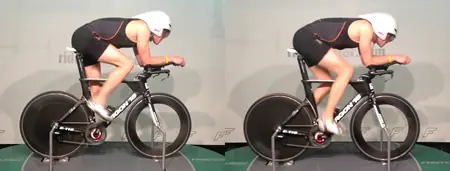Because of her body proportions, Cheryl was a great candidate for a custom bike. After her new bike arrived, she was able to hold her body in a better aero position. The results were very dramatic—with a 261-gram drag reduction! That equates to 2.6 seconds per kilometer...in an Ironman, that would be 7:48 faster. In addition to an aero advantage, she had more power to the pedal and was much more comfortable on her bike, allowing her to sustain this position on the road. Cheryl was able to get her torso much lower while keeping her hip angle open.
When we do aerodynamic testing, we also look at helmet options, wheels and where to place nutrition and hydration on the bike. Depending on the rider and how they react to the equipment in the wind flow, we can then start to select wheels, clothing, and helmets that are best suited for them. Many times we have found unconventional ways of making athletes faster.
Another great example of the effects of a proper fit and solid foundation is an Ironman athlete, Susan. We tested Susan in the wind tunnel before making any changes to her position. After going through a full fit using our 3D system, we returned to the wind tunnel for more testing.
What we found was that her position was completely hindering her performance and power but also causing her legs to be more fatigued for the run. As running was Susan's strength, we wanted to assure that her running muscles were less fatigued, allowing her to have a better run in her next Ironman. The body positional changes that we made with Susan led to a reduction of 463 grams of drag and saved her 13:53 on her next Ironman.

More: On the Bike: Fit Versus Technique
Body Position
One of the big hurdles that many amateur and pro athletes must overcome is how to hold their body's position during their triathlon or time trial. For some triathletes, they will become more aero (as much as 250 grams!) by flattening their back and turtling their head. Others are better off keeping the head in-line with their back. It all depends on how the rider can hold themselves on their bike and the surface area of the athlete.
The picture of Ted below shows a before and after where he was able to flatten his back and lose another 250-plus grams of drag. (That's 2.5 seconds per kilometer!)
More: 10 Bike Fit Myths...Debunked
Aerodynamics = Unique to Each Person
Just like bike fits are unique to each individual, aerodynamics is also unique to each person. Some people try to become more aerodynamic by purchasing a new aero bike, wheels, or a new helmet. What we have found from testing many athletes is that a solid foundation from a good bike fit can make you more aero than new equipment.
A new bike may cost you $4,500 for a 200 grams of drag reduction (about $22.50 per gram of drag). A new set of carbon aero wheels will cost you around $3,200 for 150 grams of drag reduction (about $21.33 per gram of drag). Getting a comprehensive optimization (bike fit and wind tunnel test) will cost you around $750, but can save you 350 grams of drag ($2.14 per gram of drag).
After you have a great aero position, now add in the aero equipment and you have yourself a very big competitive advantage! If you are like Cheryl above, you may need a different bike to get you in that ideal position, however many people overlook the importance of having a solid foundation and a good bike fit when it comes to an aerodynamic optimization.
More: Which Aero Equipment Offers the Most Benefits?
 Ready to go? Search for a triathlon.
Ready to go? Search for a triathlon.

